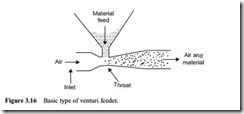Screw feeders
Much of what has been said about rotary valves applies equally to screw feeders. They are positive displacement devices, feed rate control can be achieved by varying the speed, they can be used for either positive pressure or vacuum pipeline feeding duties, air leakage is a problem when feeding into positive pressure systems, and they are prone to wear by abrasive materials.
The simple screw feeder
A simple type of screw feeder is shown in Figure 3.15. Rotation of the screw moves a continuous plug of material into the pipeline, where it is dispersed and entrained with
the conveying air. A particular advantage of screw type feeders is that there is an approximate linear relationship between screw speed and material feed rate, and so the discharge rate can be controlled to within fairly close limits.
This type of screw feeder, however, is rarely used for feeding positive pressure conveying systems. This is because there is little in their design to satisfy the basic requirement of feeding across an adverse pressure gradient. Air leakage represents a major problem with many materials, and so they are generally limited to vacuum systems where operating pressure differentials do not have to be considered.
The simple screw feeder, however, can be used in high pressure applications in combination with a lock hopper. The simple screw feeder has also been adapted for high pressure duty with the incorporation of a variable pitch screw. Both of these cases are considered in Chapter 4.
